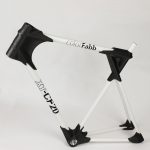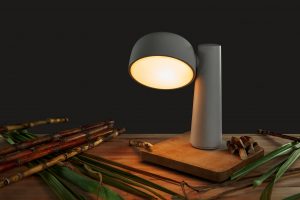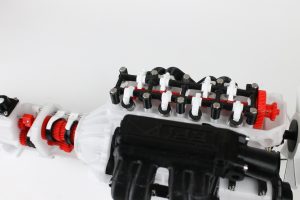
Hi and welcome back to metal printing,
I finaly got my first busts back from the polisher. It‘s pretty impressive, the material changed fully from dull and shineless to a real metal look. Now I‘m wondering if there is the possibility to achieve this finishing at home too. I tested different kinds of polishing which everyone of us could use at home: Trumbling with screws, ceramic and steel; polishing with steelwhool and sandpaper and (my favorite!) „Dremel“- tools. I like this methode and what is possible with it. But it is still far away from professional polishing. The professional one looks like real metal and mine looks more like shine plastic.
So I would like to hear about your methodes and the experiences with it. Did you already try to polish your metal prints? And if yes how does it look and what did you find out?
On the left side you can see the professional polished bust in comparison with an unpolished one. And on the right side is an unfinished print which I used for testing the Dremel – tools for polishing.
I‘m looking forward to hearing from you.
Your Ines







5 Comments
Process I came up with yesterday, after some experimentation:
1) a few grades of sandpaper, to get things smooth
2a) for flat surfaces: 2 grades of polishing wax rubbed on a piece of wood
2b) for others: same grades of polishing wax, but on a polishing wheel mounted in a dremel-like tool
3) final touches with a felt wheel and a bit of wood polishing wax
For patina, a bit of ferric chloride will darken the surface immediately
What didn’t work:
* brass wire wheel -> way too aggressive
* nylon wire wheel -> see above
* toothpaste -> no effect
* scotch brite -> a bit aggressive, tends to disintegrate
Still to try:
* stove cleaner (the kind that contains caustic soda)
* cleaning powder (it’s abrasive enough to clean stuff without scratching and contains detergent)
* building a tumbler (because all of the above involve elbow grease) 🙂
Hi Ines !
Do you know, what a “professional polishing” machine does exactly ?
If I would know, how professional services polish those prints then it would maybe be possible to find a DIY project for building a machine based on a professional one.
Of course the quality will not be as great and it might be quite an investment, but as a metal-filament-lover I would be willing to make such a project.
-Marius
Hi Marius,
no, unfortunately I don’t know it exactly, that’s the secrets they keep. I just know that the final step is worked out by a big cloth polishing weel with different layers in combination with polishing paste. There is also a smaler version of it from Dremel (http://www.dremel.com/en-us/Accessories/Pages/ProductDetail.aspx?pid=423E). That’s what I tried on my example bust. I used some abrasive buffs to make the surface rough first and worked it out with a felt polishing weel in combination with polishing compound. Then I used the smal cloth polishing weel.
But for all the steps it’s not that easy to get the right level of speed and heat between nice polishing and melting the plastic.
Maybe this could help you with your DIY project.
Let me know if you discover something. I’m curious about it.
Ines
Hi Ines,
I’m currently designing a DIY tumbler made out of Colorfabbs XT (maybe even with XT CF-20, but i have only brass nozzles)
As far as i know there is brass dust left on the print if you use brass screws in the tumbler, the same happens with stainless steel. Maybe the polishing machines used some copper pins for tumbling, this would apply the copper dust to the surface.
So far i just worked with steel wool and brass brushes (the soft ones, and you’d have to replace them often because the prints rub the brass off the brush, most brushes are steel ones covered with brass, after some time you’d have a steel brush).
I’ve got some basic workshop tools here, with that is a large polishing disk (10cm in diameter roughly). I used my table drill to get the disk spinning at ~500rpm which was a fine speed.
Beside all that i am looking for a low speed dremel, i have one here but the lowest speed is 5000rpm and with brass-wire disks i won’t polish the print, but melt through it.
Do you have recommendations for one ?
Beside all that I am also working on a cheat to get the copper look, I’m talking about electrolytic galvanisation. With applied conductive paint I am able to cover any 3d print with various metals 😉
-Marius
Hi Marius,
I also tested a tumbler with brass screws. The result was a golden shining model which I had to fix with some spray. Because it’s like you said, there is some dust left on the print. It was really shine but every material was shining golden instead of it’s own color in the end. (unfortunately I can not add a picture with this comment)
Maybe I should try it with stainless steel too.
I’m using the Dremel 300 Series. It says that it’s already on 10000 rpm at the lowest speed rate. But I was just using it on the lowest speed and just with soft tools. The only brush I was using was the 512S sanding brush all the other brushes I tested were too hard. Maybe it would be an Idea to use the tumbler with brass screws first and then some postprocessing with the Dremel.
I had the idea of a painted version too. And I really found some methodes with pastes and liquids to cover every material you want with a film wich looks like metal in the end. But I’m not really happy about a methode like this because in this case I can also use any other filament and cover it 😉 Or are there differences? I did not try it yet. If you have pictures I would be happy to see it once.
– Ines